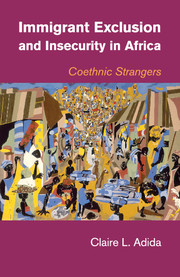Book contents
- Frontmatter
- Dedication
- Contents
- List of Figures
- List of Tables
- Acknowledgments
- 1 Introduction
- 2 Immigrants and Their Leaders
- 3 Immigrant Exclusion from Host Societies
- 4 Alternative Explanations
- 5 Mass Immigrant Expulsions in Africa
- 6 Conclusion
- Appendix A Constructing the Immigrant Attachment Index
- Appendix B Constructing the Cultural Overlap Index
- Appendix C List of Mass Expulsions and Variable Description
- Bibliography
- Index
4 - Alternative Explanations
Published online by Cambridge University Press: 05 July 2014
- Frontmatter
- Dedication
- Contents
- List of Figures
- List of Tables
- Acknowledgments
- 1 Introduction
- 2 Immigrants and Their Leaders
- 3 Immigrant Exclusion from Host Societies
- 4 Alternative Explanations
- 5 Mass Immigrant Expulsions in Africa
- 6 Conclusion
- Appendix A Constructing the Immigrant Attachment Index
- Appendix B Constructing the Cultural Overlap Index
- Appendix C List of Mass Expulsions and Variable Description
- Bibliography
- Index
Summary
The evidence used in this book to substantiate the claim that cultural overlap may yield greater exclusion among immigrant minorities in urban West Africa is drawn from several sources of data. Interview data with Yoruba, Hausa, and indigenous members of Accra, Cotonou, and Niamey provide qualitative evidence linking cultural overlap to the threat of group identity loss and to greater immigrant group attachment. Survey data with Yoruba and Hausa immigrants in Accra, Cotonou and Niamey provide quantitative evidence linking cultural overlap to greater immigrant group attachment. Survey data with indigenous members of Accra and Niamey provide quantitative statistical evidence linking cultural overlap to greater host exclusion. These diverse sources of data are woven together in this book to substantiate a counterintuitive claim that cultural similarities can exacerbate immigrant exclusion.
In this chapter I provide additional evidence for the argument, tackling questions of internal and external validity that are characteristic of largely observational data. First, I demonstrate the robustness of my findings. Second, I dispel concerns about potential confounding effects. Finally, I tackle other methodological issues specific to the use of survey instruments.
- Type
- Chapter
- Information
- Immigrant Exclusion and Insecurity in AfricaCoethnic Strangers, pp. 94 - 117Publisher: Cambridge University PressPrint publication year: 2014

